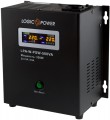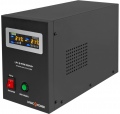Form factor
—
Standard (Tower). UPS designed for floor mounting or placement on any suitable horizontal surface. This “installation” is extremely simple, and it is suitable even for the most powerful and heaviest devices, and therefore most modern uninterruptible power supplies (of all categories) are made in the usual Tower form factor. They are supposed to be placed vertically.
—
Rack. Models for installation in telecommunication racks. Most of these uninterruptible power supplies belong to the professional equipment segment, designed to power servers and other similar electronics (which are also often mounted in a similar way). The most common standard of racks is 19", however there are other options, so it would not hurt to check the compatibility of the UPS with a specific rack separately. We also note that models of this type are often equipped with legs that allow you to place the device on the floor “sideways” or in a vertical position. Display (if available) in such models may have a rotating design for ease of reading parameters in both positions.
—
Wall-mounted. Uninterruptible power supplies, primarily designed for wall mounting. Wall hanging may be the best option in tight spaces. However, such an installation is not the only option - many devices can optionally be installed on the floor. Also note that wall-mounted UPSs are often used for heating boile
...rs. The main disadvantage of this form factor is the need to drill into the walls to install an uninterruptible power supply.
- Flat. UPS, structurally assembled in a low, flat housing. As a rule, this form factor allows for several options for installing equipment: the uninterruptible power supply can be installed horizontally or vertically. However, it is the horizontal method of installing the UPS that predominates. In fact, everything depends on the location of the uninterruptible power supply and its dimensions - it would not hurt to clarify this point separately.
— Extension cord. Uninterruptible power supplies that resemble an extension cord in appearance. Structurally, such UPSs consist of a set of sockets in one housing, with the sockets located on the top platform of the uninterruptible power supply. Often, the housing of such UPSs is provided with holes or fasteners for wall mounting.Switching to battery
The time required to transfer the load from mains power to battery power. In standby and
interactive UPSs (see Type), a short-term power failure occurs at this moment — accordingly, the shorter the time to switch to the battery, the more uniform the power supply is provided by the source during a power failure. Ideally, the switching time for the traditional 50 Hz AC frequency should be less than 5 ms (a quarter of one cycle of the sine wave). With inverter UPSs, the transfer time is, by definition, zero.
Input voltage range
In this case, the input voltage range is implied, in which the UPS is able to supply a stable voltage to the load only due to its own regulators, without switching to the battery. For redundant UPSs (see "Type") this range is quite small, approximately 190 to 260 V; for interactive and especially inverter ones, it is much wider. Some UPS models allow you to manually set the input voltage range.
Bypass (direct connection)
Bypass(by-pass) means such a mode of operation of the UPS, in which power is supplied to the load directly from an external source — the mains, diesel generator, etc. — practically without processing in the UPS itself. This mode can be activated either automatically or manually.
— The automatic bypass is a kind of safety measure. It turns on when the UPS in normal mode cannot supply power to the load — for example, when the UPS is overloaded due to a sharp increase in the power consumption of the load.
— Manual bypass allows you to enable this mode at the request of the user, regardless of the operating parameters. This may be necessary, for example, to hot-swap a battery (see below for details) or to start equipment that has a starting capacity greater than that of the UPS. Technically, it can also play the role of a security measure, but automatic systems are more reliable in this sense.
Some UPSs provide both options for enabling the bypass.
Output voltage accuracy
This parameter characterizes the degree of difference between the AC voltage at the output of the UPS and the perfect voltage, the graph of which has the shape of a regular sinusoid. The perfect voltage is so named because it is the most uniform and creates the least unnecessary load on the connected devices. Thus, the distortion of the output voltage is one of the most important parameters that determine the quality of the power received by the load. A distortion level of 0% means that the UPS produces a perfect sine wave, up to 5% — slight sine wave distortion, up to 18% — strong distortion, from 18% to 40% — a trapezoidal signal, more than 40% — a square wave.
Output frequency
The frequency (frequency range) of the AC voltage output by the UPS. For computer technology, the frequency range of 47-53 Hz is considered normal, although the smaller the deviation from the 50 Hz standard, the better. On the other hand, in some UPS models, this frequency can be automatically synchronized with the frequency of the mains — so the power supplied to the load will not differ regardless of whether the load is powered by the mains or from the battery. In this case, a wider frequency range, on the contrary, is more desirable.
Redundant sockets
The number of
outlets connected to the power reserve(battery) provided in the design of the UPS. In order for the UPS to fulfill its main role (providing a backup power in case of power outages), the corresponding electrical appliances must be connected to these outlets. The sockets have a standard shape and are compatible with the vast majority of popular 230 V plugs.
At a minimum, the UPS has
1 or
2 outlets and, in more advanced ones, there may be
3 or
more.
Min. charging current
The lowest current value in Amperes at which the UPS battery can be effectively charged. Note that charging with low currents is considered more gentle and extends the service life of the battery, but this increases the duration of the charging process. The optimal charge current is about 10% of the battery capacity.
Max. charging current
The maximum current in Amperes that charges the UPS battery or battery pack. Frequent charging cycles with high currents reduce the battery's service life. However, charging in this mode will come in handy during regular power outages - it makes sense to use
high charging currents when you need to charge the batteries as quickly as possible while the power is on and be fully prepared for the next power outage.

